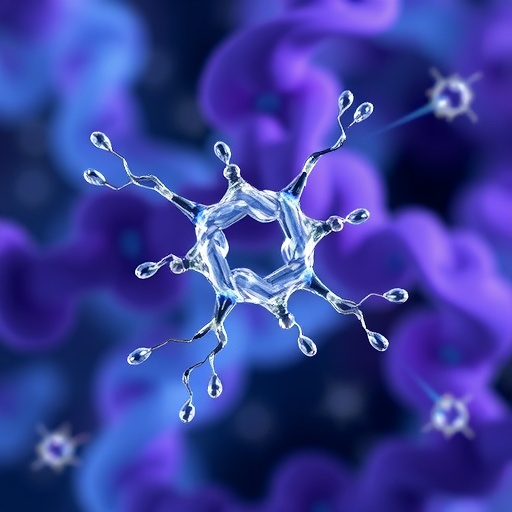In a groundbreaking discovery that could revolutionize the treatment of inflammatory diseases, researchers have identified nitroxoline as a potent inhibitor of NLRP3-dependent pyroptosis, unveiling a promising new avenue in the fight against chronic inflammation and related pathologies. This novel finding, detailed in the latest issue of Cell Death Discovery, illuminates a previously unrecognized role for nitroxoline, a clinically established antibiotic, in modulating the intricate processes that trigger a highly inflammatory form of programmed cell death known as pyroptosis.
At the heart of this study lies the intricate molecular machinery of the NLRP3 inflammasome, a multi-protein complex that serves as a central orchestrator of innate immune responses. The activation of NLRP3 inflammasomes culminates in the cleavage and activation of caspase-1, which then processes pro-inflammatory cytokines such as interleukin-1β (IL-1β) and interleukin-18 (IL-18). Importantly, caspase-1 also initiates pyroptosis by cleaving gasdermin D, forming pores in the cell membrane that lead to cell swelling, lysis, and the release of inflammatory mediators. While essential for host defense against pathogens, excessive or uncontrolled activation of NLRP3 and pyroptotic cell death has been implicated in a myriad of diseases, ranging from autoinflammatory syndromes to neurodegenerative disorders and metabolic diseases.
The research team, led by Maeder and colleagues, embarked on a comprehensive chemical screen to identify compounds capable of specifically inhibiting NLRP3-dependent pyroptosis without broadly suppressing immune function. Through meticulous in vitro assays and cellular models, nitroxoline emerged as a standout candidate, demonstrating robust suppression of NLRP3 inflammasome activation and subsequent pyroptotic events. Notably, nitroxoline’s inhibitory effects were observed at nanomolar concentrations, underscoring its potency and therapeutic potential.
Delving deeper into the mechanistic underpinnings, the investigators found that nitroxoline interferes with the assembly and activation of the NLRP3 inflammasome complex. Unlike general anti-inflammatory agents that act downstream or broadly inhibit cytokine production, nitroxoline appears to target upstream events crucial for inflammasome oligomerization. This targeted intervention prevents caspase-1 activation and the ensuing cascade leading to pyroptotic cell death. This specificity is particularly exciting, as it offers the possibility of dampening detrimental inflammation without crippling the host’s ability to combat infections.
From a pharmacological perspective, the repurposing of nitroxoline is a strategic advantage. Long used primarily for urinary tract infections, nitroxoline’s safety profile, bioavailability, and pharmacokinetics are well established, accelerating its potential transition from bench to bedside for inflammatory conditions. The team is optimistic that such repositioning could shorten the timeline for clinical trials, enabling faster evaluation in diseases characterized by aberrant NLRP3 activity.
The implications of inhibiting NLRP3-dependent pyroptosis are profound. Diseases such as gout, type 2 diabetes, Alzheimer’s disease, and atherosclerosis share a common pathological thread involving inflammasome-mediated inflammation. By curtailing pyroptotic cell death, nitroxoline may protect tissue integrity while limiting excessive cytokine release that exacerbates disease progression. Moreover, the drug’s capacity to modulate sterile inflammation opens new therapeutic possibilities beyond infectious disease contexts.
To verify the translational potential of their findings, the researchers employed animal models of inflammasome-driven pathology. Treatment with nitroxoline correlated with marked reductions in inflammatory markers and improved tissue histology, reinforcing its efficacy in vivo. These promising preclinical results not only validate the molecular data but also bolster the case for advancing nitroxoline towards human trials aimed at managing chronic inflammatory disorders.
The study also explored how nitroxoline’s mode of action compares with other known inflammasome inhibitors. While several agents targeting NLRP3 have emerged, many face limitations regarding specificity, off-target effects, or pharmacological challenges. Nitroxoline’s unique chemical structure and mechanism confer advantages, such as minimizing immunosuppression-associated risks and offering a dual role as an antimicrobial and anti-inflammatory agent.
Beyond therapeutic considerations, this research highlights the expanding appreciation of pyroptosis as a double-edged sword within the immune system. While essential for defense, unchecked pyroptosis can drive tissue damage and promote pathological inflammation. By unveiling new molecular inhibitors such as nitroxoline, scientists are gaining precise control over this potent cell death pathway, paving the way for innovative treatments grounded in the modulation of innate immunity.
Future directions will likely extend towards unraveling nitroxoline’s interaction dynamics with inflammasome components at the atomic level, guiding structure-based drug optimization. Additionally, clinical investigations will need to assess the drug’s efficacy and safety in diverse patient populations afflicted with inflammasome-linked diseases. Collectively, these efforts may herald a new class of anti-inflammatory strategies rooted in fine-tuned immune modulation rather than broad-spectrum immunosuppression.
The discovery also raises intriguing questions about the interplay between antimicrobial agents and innate immune pathways. Nitroxoline’s dual function challenges conventional drug classification, positioning it as a multitasking molecule that bridges infection control and inflammation resolution. This paradigm shift underscores the potential hidden within existing pharmacopeia to address complex diseases through innovative repurposing.
As the scientific community digests these findings, excitement builds around the prospect of taming inflammasome-driven diseases that have long eluded effective treatment. The research by Maeder et al. exemplifies the power of integrative approaches combining medicinal chemistry, molecular immunology, and translational models to unlock new therapeutic possibilities from known compounds.
In essence, the identification of nitroxoline as a novel inhibitor of NLRP3-dependent pyroptosis marks a significant leap forward in immunopharmacology and offers renewed hope for patients suffering from debilitating inflammatory conditions. As this research progresses towards clinical validation, it may inaugurate a new era in which targeted control of pyroptosis transforms our approach to inflammation and immune-mediated diseases.
Subject of Research: Inhibition of NLRP3-dependent pyroptosis by nitroxoline
Article Title: Nitroxoline is a novel inhibitor of NLRP3-dependent pyroptosis
Article References:
Maeder, C., Baumann, R., Gaul, S. et al. Nitroxoline is a novel inhibitor of NLRP3-dependent pyroptosis. Cell Death Discov. 11, 394 (2025). https://doi.org/10.1038/s41420-025-02699-z
Image Credits: AI Generated




